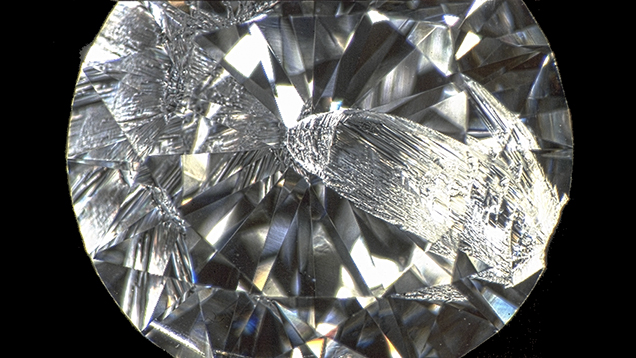Fractured Diamond: What It Is and How It Affects the Diamond
A fractured diamond refers to a diamond that has an internal fracture, often called a fracture or crack. These fractures can occur during the diamond’s formation or due to external pressure or mishandling during the cutting process. The fracture may be visible or microscopic, depending on the severity.
Types of Fractures in Diamonds
Internal Fracture (Inclusion):
What It Is: This refers to a crack or break inside the diamond, which can occur naturally during its formation or as a result of external pressure.
How It Affects the Diamond: An internal fracture can affect the diamond’s clarity grade. If the fracture is large or visible, it can lower the diamond’s quality and affect its brilliance and durability. These fractures are often categorized under inclusions in clarity grading.
Surface Fracture (Blemish):
What It Is: A surface fracture, or blemish, is a crack on the outer surface of the diamond, usually caused by accidental damage.
How It Affects the Diamond: While these types of fractures are visible to the naked eye and can detract from the diamond’s overall appearance, they generally don’t impact the diamond’s internal integrity or overall clarity grade.
Fracture-Filled Diamonds
Some diamonds with fractures may undergo a process known as fracture filling. This process involves filling the fracture with a transparent resin or glass-like substance to improve the diamond’s appearance and clarity.
How It Works:
The process involves applying heat and pressure to fill the fracture with a substance that makes the crack less visible.
The goal is to enhance clarity by making the fracture less noticeable to the naked eye.
Impact on Value:
Fracture-filled diamonds are generally less valuable than untreated diamonds because they are perceived as less durable. Over time, the filling can discolour or even break down, affecting the appearance and integrity of the diamond.
It’s important to note that diamonds treated in this way are typically marked as fracture-filled diamonds, and this treatment is disclosed on certification reports.
How Fractured Diamonds Are Graded
Diamonds with fractures will be evaluated based on the clarity grading system, which looks at the size, location, and visibility of the fracture (or inclusion):
Flawless (FL): No fractures or inclusions.
Internally Flawless (IF): No internal fractures, though surface imperfections may exist.
Very, Very Slightly Included (VVS1, VVS2): Fractures are microscopic and very difficult to see under magnification.
Very Slightly Included (VS1, VS2): Minor fractures visible only under magnification.
Slightly Included (SI1, SI2): Fractures are noticeable under magnification and may be visible to the naked eye.
Included (I1, I2, I3): Fractures are visible to the naked eye and can affect the diamond’s durability and appearance.
Potential Risks of Fractured Diamonds
Durability:
Fractures can weaken the diamond, making it more susceptible to damage. Impact or stress on the diamond may cause the fracture to worsen, especially in diamonds that have significant inclusions or fractures.
Appearance:
A visible fracture can affect the diamond’s brilliance and overall aesthetic. It may interfere with the way light interacts with the diamond, potentially causing it to appear duller or less brilliant than diamonds without fractures.
Value:
Diamonds with significant fractures are often less valuable than diamonds with better clarity grades, as the fracture detracts from the diamond’s overall beauty and durability.
Dealing with Fractured Diamonds: Should You Buy or Sell?
When Buying:
If you come across a fractured diamond, you should take extra care in evaluating its clarity and structural integrity. Depending on the location and size of the fracture, it may be worth purchasing if the price is right. However, be cautious of diamonds with large or visible fractures, as they could significantly impact the diamond’s long-term durability and appearance.
When Selling:
Selling a fractured diamond may be more challenging due to the impact of the fracture on the diamond’s value. You may want to disclose any fracture filling or inclusions, as honesty can ensure the buyer understands what they’re purchasing.
A fractured diamond can still be valuable, but its clarity, appearance, and durability may be compromised depending on the severity of the fracture. If you are buying a diamond with a fracture, it’s important to ensure you’re comfortable with the potential risks, both visually and in terms of long-term durability. If you are selling a fractured diamond, understanding how fractures can affect its value and appearance is crucial. Would you like to explore options for clarity improvement, or how to assess diamonds with fractures more thoroughly?

